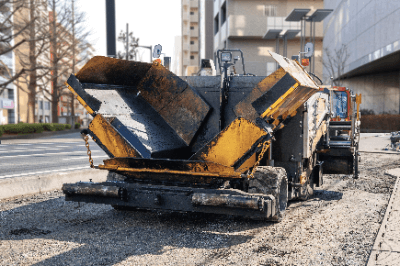What Is a Finisher?

A finisher, also known as asphalt finisher, is a machine used for paving asphalt.
It is a construction machine used when leveling the ground, such as roads, and laying asphalt. It can spread the materials that form the basis of asphalt to a specified width and thickness, compacting the ground to increase its strength.
Uses of Finisher
The primary application of an asphalt finisher is in the final stage of road construction, which involves paving asphalt. After the foundation is completed, the finisher is used to evenly spread asphalt at a consistent thickness and width.
The classification of asphalt finishers is based on the screed width. In Japan, where roads with a paving width of 6m or less are common, the use of medium-sized units is prevalent. Overseas, where roads with widths of 9m or 12m are encountered, larger units are utilized.
Structure of Finisher
Asphalt finishers can be broadly categorized into four parts.
1. Hopper
This is the box-shaped part where asphalt mixtures are stored. The left and right sides of the hopper can be opened and closed, and it contains a conveyor to transport the asphalt mixtures to the rear of the machine.
2. Tractor
This part pulls the machine’s body.
3. Screed
The screed is responsible for leveling and smoothing the asphalt. It uses screws to even out the thickness of the asphalt mixture spread by the machine. Screed widths vary, with smaller ones at 0.8m and larger ones reaching up to 16m, influencing the pavement width that can be constructed.
Additionally, the screed may be equipped with a vibrator to compact the asphalt mixture and a gas burner to prevent the asphalt from solidifying.
4. Engine
The engine serves as the power source for the entire vehicle, using diesel fuel.
Types of Finishers
Asphalt finishers are categorized into crawler-type and wheel-type based on the difference in driving wheels.
1. Crawler-type
Crawler-type finishers use caterpillars in their running mechanism. They cannot be driven on public roads since they cannot acquire license plates. While they have a lower traveling speed compared to wheel-type finishers, their large contact area provides excellent stability, making them suitable for use on steep slopes or soft ground.
2. Wheel-type
Wheel-type finishers use tires in their running mechanism. They fall under the classification of large special vehicles and can be driven on public roads once license plates are obtained.
Wheel-type finishers are self-propelled, eliminating the need for transport vehicles like those required for crawler-type finishers. While their stability is inferior to crawler-type models, recent wheel-type finishers come with four-wheel drive, reducing tire slippage and enhancing stability.
Other information on Finishers
1. License Requirements for Operation
Asphalt finishers are classified as special vehicles. To operate a wheel-type asphalt finisher, a “Small Special License” or “Large Special License” is required, depending on the size of the vehicle. However, for a small special vehicle license, it is possible to operate if one already holds a regular driver’s license. For small special vehicles, the vehicle must meet specific criteria: length under 4.7m, width under 1.7m, height under 2.8m, and a maximum speed of 15km/h.
For large special vehicles not meeting the above criteria, the maximum speed is limited to under 35km/h.
2. Qualifications Required for Paving Work
Two types of qualifications are required for pavement work using asphalt finishers:
- Vehicle-related construction machinery skills training (for leveling, transportation, loading, and excavation)
- Construction machinery construction engineer 2nd Class (Type 5)
To perform pavement work using an asphalt finisher, one must hold either of the above qualifications. The vehicle-related construction machinery skills training can be obtained by undergoing training sessions.